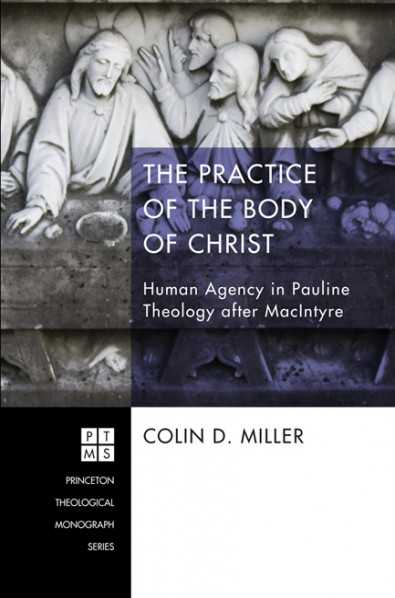Colin D. Miller’s The Practice of the Body of Christ offers a revisionist reading of Romans 5–8 and 12–15, approaching the chapters from the intersection of Apocalyptic Pauline readings, in the vein of J. Louis Martyn and Douglas Campbell, and virtue ethics in the vein of Alisdair MacIntyre.
In the first chapter, Miller follows MacIntyre’s now classic After Virtue in reconstructing a “classical model” of human activity, which involves conceptions of practice and virtue based upon the striving towards a particular good. Miller further suggests this “classical model” challenges modern Pauline studies that are too-often characterized by “hyper-Augustinian” readings, which follow two primary patterns (cf., p. 8).
The first, which Miller associates with James D. G. Dunn and (to a lesser extent) N. T. Wright, overly emphasizes the sinful nature of humanity resulting in a passive view of human agency. The second “hyper-Augustinian” reading, which Miller connects with E. P. Sanders, Martyn, and Michael Gorman, describes the Christian as primarily being acted upon by God, resulting in a real but inexplicable divine transformation of the human that again results in the passivity of the human agent. Miller concludes that these traditions have not appropriately incorporated the “classical model” of human activity and therefore inadequately handle the role of human agency in Paul.
The next three chapters construct an intricate exegetical chain suggesting that Romans 12–15 describes the concrete practices of the church that “are the content of the broader discussions of Rom 5–8” (p. 195). In Romans 5, Miller suggests that Paul is speaking not of a forensic declaration of justification, but rather of the way in which Christ makes it possible for the Church to maintain a “just practice” (p. 61). Miller understands dikaiōma—traditionally translated as “justification” in Rom 5:16—as a “just action.” The implications of this move are best seen in Miller’s translation of Rom 5:18: “Now if through the one trespass condemnation came to all people, in the same way through a just action the practice of justice that leads to life comes to all people” (p. 71). Miller contends that this interpretation is corroborated by the often unnoticed hortatory context of Rom 5:1 (for which he adopts the textual variant exōmen rather than exomen), which results in this passage speaking of “sin” and “justice” not as abstract cosmic powers but as practical human actions (p. 82–83).
Miller then proposes that the whole of Rom 6–8 lays out Paul’s description of the Church’s “participation by practice” in Christ (p. 102). Miller uses the context of Greco-Roman philosophy to suggest that Rom 6 functions as a description (vv. 1-11) and exhortation (vv. 12-23) to virtuous practice, and Romans 8 functions as a description of the Spirit’s “synergistic involvement” of transforming habits in the Christian (p. 130)
Miller argues from a perceived parallel with 1 Corinthians 8–14, that Paul’s conception of the Church as the body of Christ in Rom 12:4–5 requires an understanding of a material Spirit that is received by the Church only by means of the sacraments of baptism and Eucharist (p. 152). Having posited the inseparability of Spirt and sacrament, Miller sees Rom 12:9 as establishing a Eucharistic context in its reference to “The Unhypocritical Love Feast,” which is his translation of hē agapē anypokritos, traditionally translated as an exhortation to let love be sincere or genuine. Miller suggests Romans 12–15 discusses ecclesial practices associated with the Christian “Love Feast” or “Agape,” taking this liturgical setting as the location in which appropriate Christian virtue is defined. Within this context, Miller sees Rom 12–15 as a description of particular ecclesial practices of the Church as Christ’s body.
In his conclusion, Miller offers some preliminary implications of his work, suggesting above all that “there is plenty of room in Paul for action that can be genuinely called human and that has its place in a journey toward a telos” (p. 197). He also maintains that there is a more profound ecclesiology in Pauline ethics than is traditionally recognized. These two conclusions are the most significant aspect of Miller’s work as they touch on an innovative and profitable method of understanding early Christian ethics. Miller’s recognition of this avenue of research is insightful, and to the extent that his work raises further questions and discussion concerning the implications of ancient virtue ethics and of the ecclesial location of early Christian ethics, it is to be applauded.
The fresh re-reading of several key verses of Romans is in itself an accomplishment that will surely stimulate further thought, reflection, and discussion from anyone interested in Romans and early Christian ethics. The book does engage in extended exegetical discussions with scriptural citations consistently appearing in Greek, though readers with an English Bible handy should have no problem finding and following the references. Miller’s exegetical decisions touch on a number of particularly important themes and concepts within Romans and early Christian thought and provide plenty of avenues for continued discussion and study.
The Bottom Line: Offering a fresh re-reading of Romans in light of ancient virtue ethics and the Apocalyptic reading of Paul, Miller perceptively identifies a promising method of New Testament ethical research that has significant implications for how we read and understand early Christian ethics.
Review by Eric Covington
University of St Andrews





Leave a Reply
Your email is safe with us.